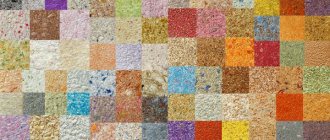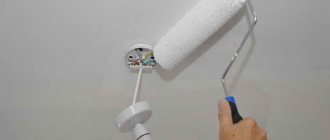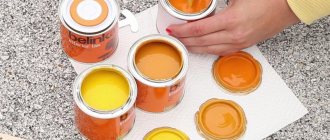Repair requires a lot of effort and time to make a high-quality update of the interior of an apartment or house. For this reason, many property owners want to reduce some of the work, especially when it comes to carrying out the finishing stage with their own hands. If the surface of the walls was previously painted, then beginners wonder: is it possible to apply paint over paint? The consequences of this decision, and in what cases this is permissible, will be discussed below.
Can paint be applied to paint?
Professionals do not recommend painting over another coloring material. For them, the stage of removing the old finish is mandatory. The reason is the danger of peeling off the previous coating, and if you apply a new layer on it, it will suffer along with the old one.
Having painted a light color on top, there is a high probability of noticing dark spots appearing through it. All flaws in the previous finish will be noticeable. In addition, not all paints and varnishes are compatible; their components may not fit each other, the layer will not apply well, and the degree of adhesion will be low.
Applying one layer to another is permissible only if the first one is in good condition, if it is perfect and lies securely on the surface. It is advisable to use similar paints and varnishes; it is optimal to paint the wall with the same types of paints.
For professionals, the stage of removing the old finish is mandatory.
What are the disadvantages
However, along with the listed advantages, nitrocellulose paint also has serious disadvantages, which include:
- A high level of toxicity, which makes NC completely non-ecological and requires the mandatory presence of personal protective equipment during work. In some countries, the use of this type of coloring composition is even prohibited. In any case, it is better to use nitro enamel for outdoor work or to ventilate the work area very well.
- The reaction of NC to an increased level of humidity, at which moldy-looking spots appear on the painted surface. To correct this deficiency, it is still recommended to add a solvent to the nitroenamel that is less volatile than the acetone included in the nitrate, for example, amyl acetate.
- Insufficient resistance to fading and fading.
- Incompatibility with many types of coloring compounds already present on the working surface - oil, latex and alkyd paints. Applying nitro enamel over an old coating will most likely cause it to swell. Also, if used incorrectly, NC can dissolve the primer layer or corrode some types of plastic.
- Low fire resistance coefficient and, as a result, an increased level of fire hazard.
- Weak impact resistance, which can cause the coating to crumble under direct mechanical impact.
- Labor-intensive painting technology that requires:
- thorough preparation of the working surface;
- applying a large number of thin layers;
- waiting for the previous coating to dry completely before applying the next layer;
- additional polishing to achieve a truly mirror-like shine.
What kind of paint can be applied to oil paint?
If you need to paint in a short time and there is no way to waste time on removing the old finish, then there is an option when the paint layer can be applied to another one. You should check the integrity of the coating and whether it adheres firmly to the base.
The assessment is made visually; you should also run your hand over the surface; swelling can be detected using this method. If there are large defects, you cannot think about applying a new layer. Such a surface will repel new material quickly.
The oil composition has a glossy structure; it is the creation of an even film that helps protect the surface from moisture, for this reason it is often used for wood. But a smooth surface is not suitable for obtaining a good degree of adhesion. Therefore, the use of re-staining is difficult.
It would be correct to remove the paint; for this purpose, you can find special removers on sale; they soften the layer, after which you can remove the paint with a spatula. The process is not fast, but you get a good basis for repairs
If the base is in good condition, and you still decide to paint, then oil or alkyd enamel is more suitable for an oil base. You can also resort to acrylic; you will need to carry out the preparatory stage, applying a primer.
Compositions based on water are not a suitable option; in order to complete the polymerization, it is necessary to saturate the surface with water, and an oil coating will not allow it to pass to the base, so drying will not take place at the proper level, and reliable adhesion will not be obtained.
The oil composition has a glossy structure; it is the formation of an even film that helps protect the surface from moisture.
Minuses
Application of this composition in very humid rooms can lead to the appearance of whitish stains on surfaces, as well as various stains. This can be explained by the fact that the evaporation of acetone included in the paint occurs extremely quickly, which cools the surface. To eliminate this harmful effect, you need to use a solvent that is not very volatile. Finishing work must not be carried out indoors with humidity levels greater than 70%.
Very serious disadvantages are toxicity and flammability. You can only work with such substances using respirators, in well-ventilated areas or outdoors.
If necessary, it is permissible to dilute the nitro paint with acetone or special licensed nitro solvents.
Is it possible to paint with oil paint over oil paint?
Is it possible to paint with oil paint over oil paint? Many property owners who decide to refresh the color of the walls ask this question. This option is optimal if you need to skip the stage of removing the old coating. To get better adhesion, it is advisable to sand the base, removing the glossy layer.
To get better adhesion, it is advisable to sand the base, removing the glossy layer.
Is it possible to paint with acrylic paint over oil paint?
The question of whether it is possible to paint with acrylic paint over oil paint can be answered in the affirmative. But a special type must be used - Master 121 paint. Taking into account that the surface has no flaws, the layer does not peel off or crack, only such a wall can be re-painted.
Master 121 is an acrylic enamel that is distinguished by its high adhesion to any type of substrate; it can even be applied to a glossy surface. This product will help to obtain a reliable and strong adhesion of the product to oil-type acrylic. But even the quality of good adhesion requires preliminary preparation of the base:
- First of all, the surface is sanded; fine-grained sandpaper is used for this purpose.
- The wall is washed, all dirt and grease should be removed.
- The surface must dry completely before painting; after the required time has passed, the wall is painted.
To improve the result, an equal amount of water should be added to the paintwork material; applying a more liquid product will make it easier to obtain an even and uniform distribution of the composition.
If you intend to distribute paint over the wall with a spray bottle, then you need to dilute it with special solvents.
Master 121 is an acrylic enamel that is distinguished by its high adhesion to any type of substrate.
Is painting over nitro enamel allowed?
It is not allowed to paint surfaces treated with nitro enamel for a number of reasons:
- Cracks or peeling paint.
- Violation of the integrity of the coating.
- Different chemical compositions can cause a negative reaction, causing the color to deteriorate.
If there is a need to restore the attractiveness and integrity of the coating, then the same nitro enamel is suitable, which is applied in accordance with the following rules:
- The coating must be treated with a fine abrasive material.
- The surface must be completely cleaned of dirt and dust.
- Using a soap solution, the coating is degreased.
- Leave for some time to dry completely.
To obtain a durable coating, it is recommended to use a primer and apply paint in two layers, since this ensures not only mechanical resistance, but also color uniformity.
Is it possible to paint with alkyd paint over oil paint?
Often windows, radiators, ceilings and walls are painted with oil-based compounds. However, modern technologies have made it possible to create more advanced types of paints, for this reason many want to replace the material. Alkyd enamel has many advantages.
If an alkyd resin-based paint is chosen to repaint the paint, then the old oil-based coating must be removed. Only if the previous finish is securely fixed can re-painting be allowed.
Then the wall is sanded, the remaining dust and dirt after the process is washed off with an aqueous solution with soda. After the base has dried, the finished solution can be applied; several layers will be required, it is important that each of them is completely dry.
If an alkyd resin-based paint is chosen to repaint the paint, then the old oil-based coating must be removed.
Areas of application of nitro paints
Nitrocellulose coatings are used for painting:
- wooden boards, products, floors;
- Chipboard, MDF;
- furniture facade;
- metal products, devices;
- stair railings;
- sheet metal;
- polystyrene;
- concrete surfaces;
- plastered walls;
- internal parts, car body;
- restoration of vintage cars;
- objects at a construction site (for marking).
See also
6 suitable types of paint for a concrete fence and step-by-step application
Is it possible to paint with enamel over acrylic paint?
The acrylic type is distinguished by the presence of water in the composition, which contributes to the environmental friendliness of the composition, it does not smell unpleasant, and also does not emit harmful components when drying. The presence of water makes it possible to paint over other paints and varnishes, including enamels. First you need to clean the wall of dirt and apply a primer, then adhesion will be better. Of course, such finishing is only possible on strong substrates, without cracking.
The presence of water makes it possible to paint over other paints and varnishes, including enamels.
How to choose
The choice of paint begins with determining how it will be used: interior, decorative or applied. There are two types of paint composition: organic and synthetic. Each of them is based on artificial resins. Dyes are used to create coloring pigment. Artificial pigments appear in bright and rich colors, and the natural base appears in pastel colors.
As already mentioned, acrylic is a universal type of paint and varnish materials. It can be used in any room. Acrylic dye is not afraid of moisture. You don't have to be a master to carefully cover any surface with it. First of all, buyers choose a material by color, then turn to information about the purpose. It can be found on the packaging. There is permanent paint, for ceilings, for facades or for interior work.
So, there are usually several types of acrylic paints:
- Wear-resistant
paint is recommended for rooms with high levels of humidity. - Deep matte and matte
paints are suitable for walls and ceilings in dry rooms. They hide small and insignificant irregularities, are easy to apply and have breathable properties. Before this, you need to remove the whitewash from the ceiling. - Glossy
paint does not hide unevenness and visually enhances texture.
The color range of paints is wide.
It is possible to make the shade yourself; for this, colors are used. They interfere with the white color and create the desired shade. Kohler is a concentrated paint. It can be thick or liquid.
It is enough to follow the following points to properly mix the paint with the color:
- carefully read the instructions and color chart;
- use paint and colors from the same manufacturer;
- mix them in a separate container;
- You only need to mix the amount that needs to be used for painting at the moment.
Exterior paint
used to cover house facades and other outdoor items.
There are two types of paint for facade work: water-based and based on organic compounds. The second is especially good for working at low temperatures in winter. It lays flat and dries quickly at sub-zero temperatures. Acrylic paint is highly wear-resistant, highly protective and durable, making it suitable for concrete products. The paint protects concrete from the influence of weather conditions and mechanical stress.
Acrylic-based coating is also chosen for wooden products. It has the following properties:
- resistance to changes in temperature and moisture;
- wear resistance prevents cracks from forming on the wooden surface;
- retains color for ten years;
- it is characterized by vapor permeability;
- dries quickly;
- easy to use;
- no need to scrape off the old layer to apply a new coat of paint.
Artists and designers use acrylic to paint furniture, create patterns on glass, designs on fabric and for painting.
There is acrylic for children's creativity - this paint is brighter and easier to wash off. It is non-toxic and is stored in plastic jars. There are also paints that have special properties, such as glow in the dark, fluorescent and pearlescent.
Paint for decorative works
Available in jars and tubes. Both forms of storage are convenient to use. Paint in tubes can be purchased individually. It is worth noting that jars and tubes of paint come in different sizes. Acrylic fabric paints are distinguished by their elastic properties. When heated with an iron, they acquire a plastic structure and penetrate into the fabric. After dyeing, it is recommended to wash items by hand.
Acrylic nail
It is also stored in jars and tubes. The material in the jars is necessary to create a pattern with a brush or using other tools. If necessary, the paint can be diluted with water. Thanks to the narrow spout at the end of the tube, the paints are ready for use immediately. Tubes can also be purchased individually.
How to paint walls with water-based paint over oil-based paint
The water-based composition is also produced using water. To obtain the necessary fixation of the layer, it must be saturated into the base. But the oil composition will not give water such an opportunity, it will simply push it away from itself.
For this reason, part of the layer will adhere well, in those places where the gloss has come off, and part will simply not adhere. To avoid such consequences, apply a layer of drying oil; it will create a good base for adhesion. Or a primer solution is used.
To obtain the necessary fixation of the layer, it must be saturated into the base.
Advantages of acrylic compositions
Acrylic paints have long and firmly conquered the construction market for several reasons:
- The compositions do not have an unpleasant odor, are harmless to use and environmentally friendly to use;
- The ability to select the color of the coating is limited solely by the owner’s imagination;
- Very easy to apply: work can be carried out using a brush, roller or spray gun;
- Dries quickly;
- They have a long service life: when applied correctly, the coating lasts for decades without losing color.
What kind of paint can acrylic paint be applied to?
To paint an oil base with an acrylic composition, first apply a primer mixture; it will create the necessary level of adhesion of the two products. The water-based base must be ideal, then it will be possible to apply an acrylic-based product. But it is always better to remove the previous finish. Then the coloring will be of high quality.
It is possible to use a latex layer on top; it is important that the acrylic is of high quality. Then the degree of adhesion will be good, the compositions will be able to adhere well.
It is possible to use a latex layer on top; it is important that the acrylic is of high quality.
Is it possible to paint with oil paint on nitro enamel?
The oil type of wall painting material has an oily structure that is poorly compatible with nitro enamels. If you apply them on top of each other, the following problems may appear:
- Formation based on cracks and bubbles;
- Changing the shade of the product, which ultimately will not allow you to get the desired design of the room;
- The paint life will be short.
The oil type of wall painting material has an oily structure that is poorly compatible with nitro enamels.
Is it possible to paint with oil paint on enamel?
Oil base and enamels are similar in their components, which helps to use them together. If necessary, the formulations can be mixed together. It is also allowed to paint them on top of each other.
But the condition for the reliability of the base remains unchanged for any composition. The surface should be cleaned of all types of contaminants and thoroughly degreased. The new product should be applied in several layers. The importance of drying each one is undeniable, so don’t rush, otherwise the paint will be ruined and won’t last long.
The new product should be applied in several layers.
The article provided a detailed answer to the question: is it possible to apply paint to old paint? The technology of work includes the mandatory removal of old materials, but sometimes it is not possible to carry out this stage. Then the condition of the surface is assessed and compatible products are selected.
About paint compatibility
Many people wonder whether it is possible to apply acrylic paint on top of oil paint, and vice versa, enamel on an acrylic base?
Attention! To begin with, it is recommended to coat the surface with epoxy putty.
- It is advisable to apply acrylic paint only to a similar coating;
- You cannot use alkyd and epoxy resins to paint past glossy and varnished bases;
- Any coating can be applied to dispersion and emulsion materials.
>











